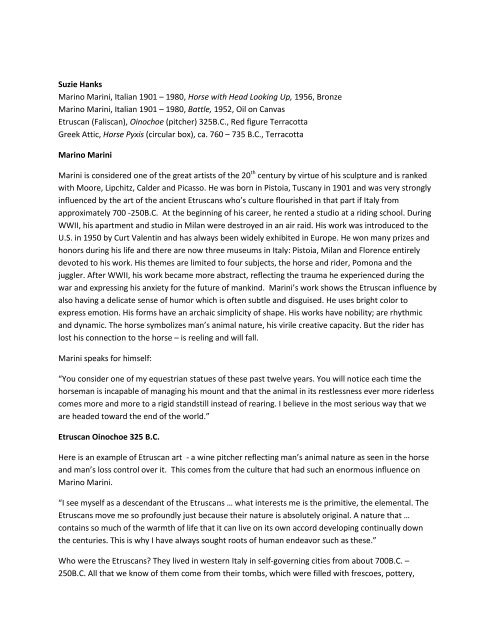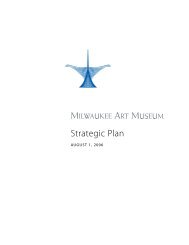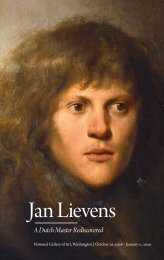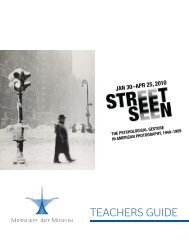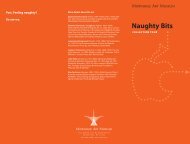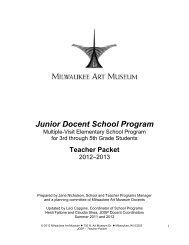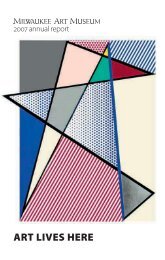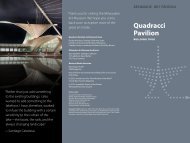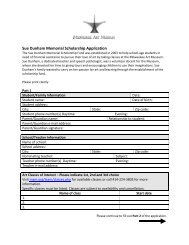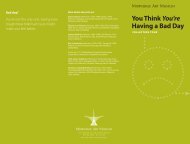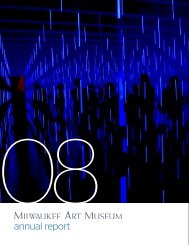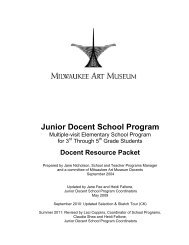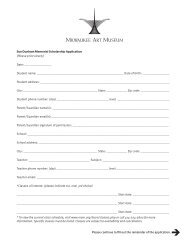Juxtapositions-Notes - Milwaukee Art Museum
Juxtapositions-Notes - Milwaukee Art Museum
Juxtapositions-Notes - Milwaukee Art Museum
You also want an ePaper? Increase the reach of your titles
YUMPU automatically turns print PDFs into web optimized ePapers that Google loves.
Suzie Hanks<br />
Marino Marini, Italian 1901 – 1980, Horse with Head Looking Up, 1956, Bronze<br />
Marino Marini, Italian 1901 – 1980, Battle, 1952, Oil on Canvas<br />
Etruscan (Faliscan), Oinochoe (pitcher) 325B.C., Red figure Terracotta<br />
Greek Attic, Horse Pyxis (circular box), ca. 760 – 735 B.C., Terracotta<br />
Marino Marini<br />
Marini is considered one of the great artists of the 20 th century by virtue of his sculpture and is ranked<br />
with Moore, Lipchitz, Calder and Picasso. He was born in Pistoia, Tuscany in 1901 and was very strongly<br />
influenced by the art of the ancient Etruscans who’s culture flourished in that part if Italy from<br />
approximately 700 -250B.C. At the beginning of his career, he rented a studio at a riding school. During<br />
WWII, his apartment and studio in Milan were destroyed in an air raid. His work was introduced to the<br />
U.S. in 1950 by Curt Valentin and has always been widely exhibited in Europe. He won many prizes and<br />
honors during his life and there are now three museums in Italy: Pistoia, Milan and Florence entirely<br />
devoted to his work. His themes are limited to four subjects, the horse and rider, Pomona and the<br />
juggler. After WWII, his work became more abstract, reflecting the trauma he experienced during the<br />
war and expressing his anxiety for the future of mankind. Marini’s work shows the Etruscan influence by<br />
also having a delicate sense of humor which is often subtle and disguised. He uses bright color to<br />
express emotion. His forms have an archaic simplicity of shape. His works have nobility; are rhythmic<br />
and dynamic. The horse symbolizes man’s animal nature, his virile creative capacity. But the rider has<br />
lost his connection to the horse – is reeling and will fall.<br />
Marini speaks for himself:<br />
“You consider one of my equestrian statues of these past twelve years. You will notice each time the<br />
horseman is incapable of managing his mount and that the animal in its restlessness ever more riderless<br />
comes more and more to a rigid standstill instead of rearing. I believe in the most serious way that we<br />
are headed toward the end of the world.”<br />
Etruscan Oinochoe 325 B.C.<br />
Here is an example of Etruscan art - a wine pitcher reflecting man’s animal nature as seen in the horse<br />
and man’s loss control over it. This comes from the culture that had such an enormous influence on<br />
Marino Marini.<br />
“I see myself as a descendant of the Etruscans … what interests me is the primitive, the elemental. The<br />
Etruscans move me so profoundly just because their nature is absolutely original. A nature that …<br />
contains so much of the warmth of life that it can live on its own accord developing continually down<br />
the centuries. This is why I have always sought roots of human endeavor such as these.”<br />
Who were the Etruscans They lived in western Italy in self-governing cities from about 700B.C. –<br />
250B.C. All that we know of them come from their tombs, which were filled with frescoes, pottery,


